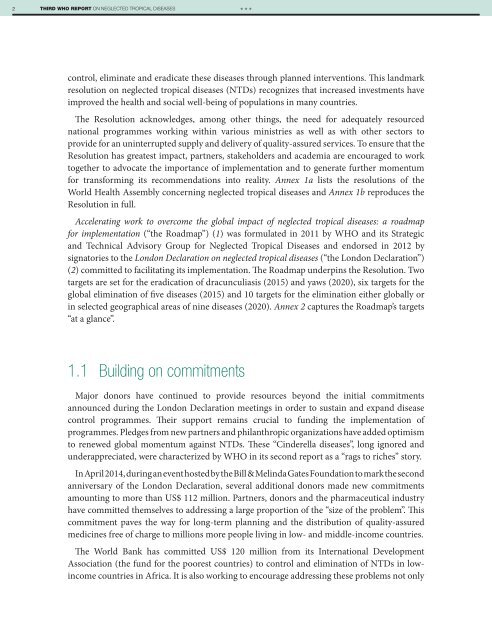1A9bnbK
1A9bnbK
1A9bnbK
Create successful ePaper yourself
Turn your PDF publications into a flip-book with our unique Google optimized e-Paper software.
2 THIRD WHO REPORT ON NEGLECTED TROPICAL DISEASES<br />
***<br />
control, eliminate and eradicate these diseases through planned interventions. This landmark<br />
resolution on neglected tropical diseases (NTDs) recognizes that increased investments have<br />
improved the health and social well-being of populations in many countries.<br />
The Resolution acknowledges, among other things, the need for adequately resourced<br />
national programmes working within various ministries as well as with other sectors to<br />
provide for an uninterrupted supply and delivery of quality-assured services. To ensure that the<br />
Resolution has greatest impact, partners, stakeholders and academia are encouraged to work<br />
together to advocate the importance of implementation and to generate further momentum<br />
for transforming its recommendations into reality. Annex 1a lists the resolutions of the<br />
World Health Assembly concerning neglected tropical diseases and Annex 1b reproduces the<br />
Resolution in full.<br />
Accelerating work to overcome the global impact of neglected tropical diseases: a roadmap<br />
for implementation (“the Roadmap”) (1) was formulated in 2011 by WHO and its Strategic<br />
and Technical Advisory Group for Neglected Tropical Diseases and endorsed in 2012 by<br />
signatories to the London Declaration on neglected tropical diseases (“the London Declaration”)<br />
(2) committed to facilitating its implementation. The Roadmap underpins the Resolution. Two<br />
targets are set for the eradication of dracunculiasis (2015) and yaws (2020), six targets for the<br />
global elimination of five diseases (2015) and 10 targets for the elimination either globally or<br />
in selected geographical areas of nine diseases (2020). Annex 2 captures the Roadmap’s targets<br />
“at a glance”.<br />
1.1 Building on commitments<br />
Major donors have continued to provide resources beyond the initial commitments<br />
announced during the London Declaration meetings in order to sustain and expand disease<br />
control programmes. Their support remains crucial to funding the implementation of<br />
programmes. Pledges from new partners and philanthropic organizations have added optimism<br />
to renewed global momentum against NTDs. These “Cinderella diseases”, long ignored and<br />
underappreciated, were characterized by WHO in its second report as a “rags to riches” story.<br />
In April 2014, during an event hosted by the Bill & Melinda Gates Foundation to mark the second<br />
anniversary of the London Declaration, several additional donors made new commitments<br />
amounting to more than US$ 112 million. Partners, donors and the pharmaceutical industry<br />
have committed themselves to addressing a large proportion of the “size of the problem”. This<br />
commitment paves the way for long-term planning and the distribution of quality-assured<br />
medicines free of charge to millions more people living in low- and middle-income countries.<br />
The World Bank has committed US$ 120 million from its International Development<br />
Association (the fund for the poorest countries) to control and elimination of NTDs in lowincome<br />
countries in Africa. It is also working to encourage addressing these problems not only


